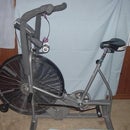Introduction: Making an Air Conditioning Condensate Drain Line Removable
An air conditioning condensate drain line slowly fills with gunk (algae, fungi, dirt, rust flakes, etc.). Then drain line quits draining and the condensed water overflows. Many times your first inkling of this problem is squishy carpet or wet socks. Of course, if you don’t get the water up out of your carpet and pad and both dried quickly, you can end up with mold.
When installed almost 40 years ago, the condensate drain line was hard plumbed. Years before I bought the house, someone had cut a wedge out of the pipe (center). I used it to get at two blockages and assume a previous owner had the same problem. The compression coupling (lower right) was added to be able pull the lower part of the condensate drain line to be able to snake the air conditioning drain to the house drain. The air conditioning drain has backed up more frequently than the condensate drain. The coil of wires (top right) lead to a battery-operated water alarm. The sensor is tucked in beside the condensate drain line to let me know if the air conditioning drain is backing up.
I figured that if I could remove the bulk of the condensate drain line, it would be easier to perform preventive maintenance. I could brush inside the short section and wash out the long section with the hose once a year and avoid condensate drain line overflows altogether.
Step 1: Gunk (algae, Fungi, Dirt, Rust Flakes, Etc.)
This is what the air conditioning condensate drain line looked like after it was removed. This was after the blockage was “cleared”.
Step 2: Equipment and Parts
In my case, this is what was needed.
Equipment
PVC pipe cutter (these make great cuts, square and no lips or debris) or a saw
Ruler
Pencil
Parts
Pipe thread to slip connector
Pipe
Union (slip)
Bends (slip)
PVC cement (adhesive)
Step 3: Assembly
Measure and cut parts to fit the existing install. Make sure to check the slip fitting depths and include them in your calculations.
There isn’t any pressure in this line, so there is no need to prime (purple) the pipe. The cement will normally be done in 15 minutes.
NOTE: Make sure the ring of the union is over the pipe and facing the correct direction before you cement those joints.
People who have worked with PVC will note the color of the cement. I couldn’t get the lid off the new cement can, so I used some old cement. For a low pressure install, it worked just fine.
Step 4: Installed
I got the dimensions right and it installed on the first try. The “before” is included for comparison. If I had thought of this before, I wouldn’t have needed the compression coupling.













